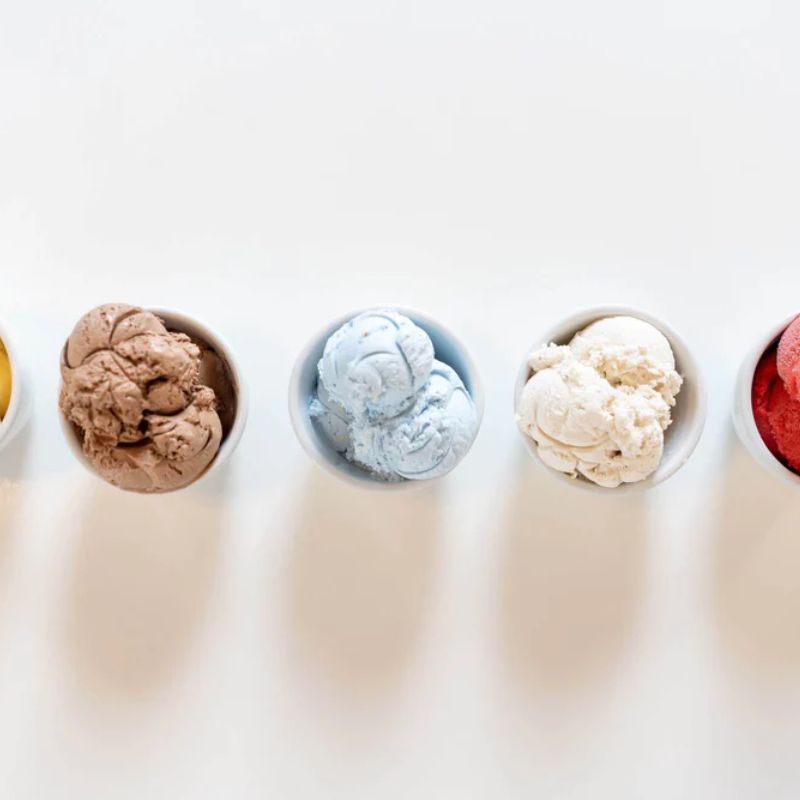“I scream, you scream, we all scream for ice cream!” Ice cream is adored by people all over the world. It seems that everyone has a favorite ice cream flavor that hits the spot on a hot summer day.
With so many frozen treats to choose from at the local grocery store, it can be easy to get confused, or maybe you just assume everything is ice cream. You may be curious what the difference between gelato and ice cream is. Then there’s frozen yogurt, sorbet, and sherbet. Let’s take a moment to understand the different types of frozen confections.
Ice Cream
Ice cream is an American staple. A trip to the beach or an outing with friends wouldn’t be complete without ice cream. Not just any frozen treat can be called ice cream, though; certain criteria must be satisfied for a product to meet the technical definition of “ice cream.” We’ll share two of the key criteria here.
First, the frozen mixture must be made with at least 10% milkfat (often referred to as butterfat). “Premium” ice cream, like that offered by ColdSnap®, contains 12-15% milkfat. The richer, creamier texture of premium ice cream keeps your favorite flavors lingering on your tongue for longer than they would with lower-fat ice cream.
Second, the amount of air introduced during the whipping process (called “overrun”), must not increase the product’s volume by more than 100%. While the addition of some air into the product helps frozen treats have a light and enjoyable texture, too much air is associated with a cheaper product. Premium ice creams are denser and have lower overrun than regular ice cream.
Much of the creaminess of ice cream comes from the ingredients. These differ just slightly between the two main American ice cream styles: Philly-style and frozen custard (also known as French ice cream). Philly-style ice cream is made with milk, cream, sugar, and flavorings. Frozen custard is comprised of similar ingredients as the Philly-style with the addition of a base containing egg yolks. With either style, the rich dairy produces a frozen dessert that is lusciously creamy.
While we’ve shared some of the American criteria for ice cream, other countries have variations around how ice cream is regulated. For example, while Australia and New Zealand also have a 10% minimum milkfat requirement, the European standard is at least 5% dairy fat.
Gelato
Meet ice cream’s Italian cousin, gelato! Its name in Italian actually means “ice cream.” This soft-frozen dessert is made similarly to ice cream but with less cream and more sugar. This results in a product with a much lower milkfat percentage – in the 4%-8% range. Typically, gelato does not contain egg yolks or stabilizers.
Gelato gets its signature soft, dense texture from its ingredients as well as the churning process – unlike ice cream, little to no air is whipped into the product. Gelato should also be served at a warmer temperature to maximize the enjoyment of the treat’s intense flavors.
Frozen Yogurt
Are you more of a “fro-yo” fan or do you prefer ice cream? In recent years, frozen yogurt has become a widely popular treat, particularly in America. It has a much lower percentage of fat compared to ice cream (3-6%) and contains beneficial, gut-friendly, bacteria.
Frozen yogurt must contain the live bacteria that are common to its unfrozen counterpart (Lactobacillus delbrueckii, subsp. bulgaricus and Streptococcus thermophilus – look at us, getting all scientific). To achieve this, yogurt bacteria are added to a portion of the milk. This cultured milk is then mixed with traditional ice cream ingredients.
Frozen yogurt is a great choice if you’re looking for a tangy-sweet treat that’s a bit lower in fat and contains some nutritional benefits. Load it up with toppings like fresh fruit, crunchy nuts, or chocolate shavings, and enjoy an enticing combination of flavors and textures.
Sorbet
If you’re looking for a light and refreshing alternative, sorbet is the frozen treat for you. Its two main ingredients are fruit (or fruit juice) and sugar, which are then churned like ice cream. It can be drier and rougher in consistency, so make sure to let it sit at room temperature before indulging.
The first versions of “ice cream” on record bore a closer resemblance to sorbets than dairy-based frozen desserts.
Sherbet
Another fruit-forward frozen treat is sherbet (did anyone else call this “sherbert” when you were growing up?). This dessert is similar to sorbet, except that it contains a touch of dairy. This makes it a smile-inducing and refreshing option.
Discover The Possibilities of ColdSnap
Ice cream stands the test of time and will continue to remain a fan favorite. But wouldn’t it be amazing if you could enjoy different flavors of ice cream at the push of a button? With the ColdSnap system, you can! Using our single-serving pods, a fresh, creamy bowl of ice cream will be waiting for you to enjoy in approximately two minutes.
So whether you’re in the mood for standard American ice cream or fruity sorbet, ColdSnap will soon be able to help make your creative frozen dessert dreams come true. Discover the possibilities at the snap of your fingertips. Contact us today.
Get the Scoop
Stay in the loop on all things ColdSnap with our newsletter.
Categories
Recent Posts
- ColdSnap Partners With Foodbuy to Deliver On-Demand Frozen Treats to Foodservice Operators
- Your Morning Just Got a Whole Lot Smoother: How to Make a Delicious & Healthy Smoothie with ColdSnap
- 7 Reasons Every Golf Course Needs a ColdSnap Machine
- Empowering Students with Self-Serve Frozen Treats — No Hassle, All Joy
- Ice Cream on Demand…From a Can??


